

Pepsi Marketing Strategy: The Case Study
Welcome to the Pepsi marketing strategy and case study to find out How Pepsi market and promotes its products in the market. So, let’s get started.
Table of Contents
About Pepsi
The Pepsi soft drink, or Pepsi-Cola, was created in 1893 by pharmacist Caleb D. Bradham, 8 years after the creation of Coca-Cola . Originally the drink was sold as a medicine to relieve intestinal disorders but for its thirst-quenching properties, it was also consumed as a drink.
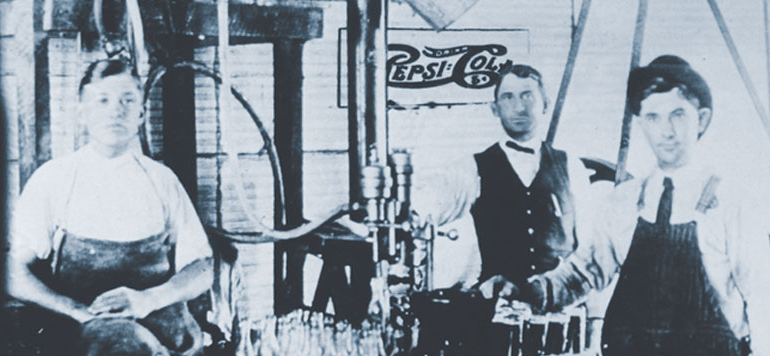
The Pepsi-Cola brand was registered by its creator in 1902 and its production intensified, so much so that Bradham was forced to relocate its production to a warehouse. However, the success was short-lived as World War I saw the price of sugar rise dramatically, so much so that the company went bankrupt. The brand was bought by Roy Megargel in the late 1920s and then, after a second bankruptcy, by Charles Guth who created The Pepsi-Cola Company. From 1964 the Pepsi range began to diversify, in particular with the sale of the first “light” cola, the Pepsi Diet.
Today there are a multitude of Pepsi varieties, some of which are only sold overseas, such as Pepsi Red, a red Pepsi sold in Japan. To beat its main competitor, Pepsi launched its first “Pepsi challenge” in 1975. After a blind tasting of Pepsi and Coca-Cola, 58% of the testers said they preferred the taste of Pepsi.
However, this study sparked controversy because the brand was accused of distorting the tasting by offering Coca-Cola that had been open for several days and lukewarm in front of Pepsi fresh from the refrigerator. Currently, the PepsiCo group markets several beverage brands in addition to Pepsi-Cola, such as 7up or Lipton Ice Tea . But the group is also present in the snacking market with brands such as Lays and Benenuts.
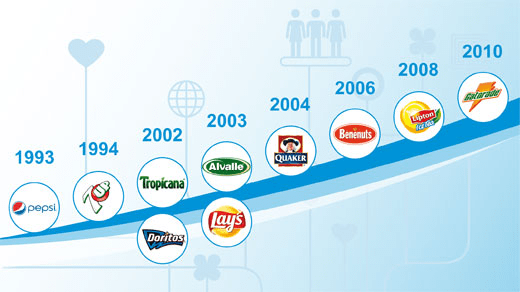
In 2012, PepsiCo was the second largest agribusiness company in the world and the first in North America by revenue, which was $ 65.5 billion. Worldwide, the group, present in 160 countries, employs more than 280,000 people.
Brand positioning
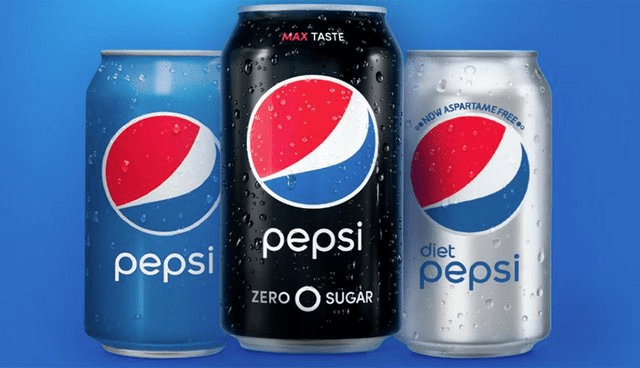
The main target audience of the Pepsi brand is clearly young people between the ages of 15 and 35, although anyone who drinks Pepsi is likely to be. However, the brand is trying to adapt to more feminine targets as well, most notably with its sugar-free drinks, one of which, Pepsi Light, was dressed in pink in 2007.
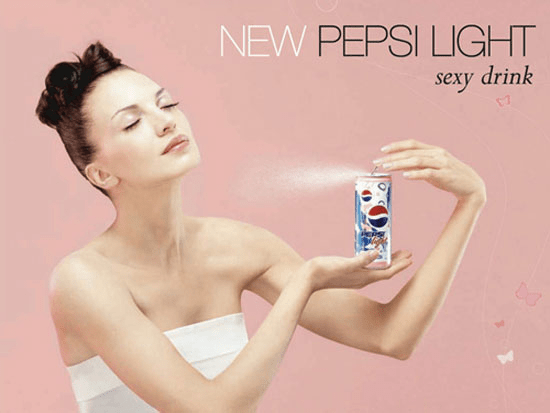
To be as close as possible to the personality of its consumers, Pepsi has managed to adopt a young, fun, and dynamic image. You can hear it in his commercials, where celebrities are particularly popular with young people, but also in his various slogans: “It’s the Pepsi generation!”, “Now… who thinks young, think Pepsi!”.
market concept
Pepsi focuses mainly on the young audience. To distinguish itself from its eternal rival Coca-Cola, which caters to all members of the family. This is why Pepsi wants to be available, and omnipresent in places mainly frequented by young people (universities, fast food restaurants, etc.). And who says youth, says limited portfolio, which leads Pepsi to position itself as an affordable and accessible product. To get closer to its target, the soft drink appeals to pop stars and wants to be provocative by daring to use comparative advertising with its rival Coca-Cola. All in a humorous way. An approach that cannot fail to enchant its main objective. One password: be “fun”.
Pepsi and advertising
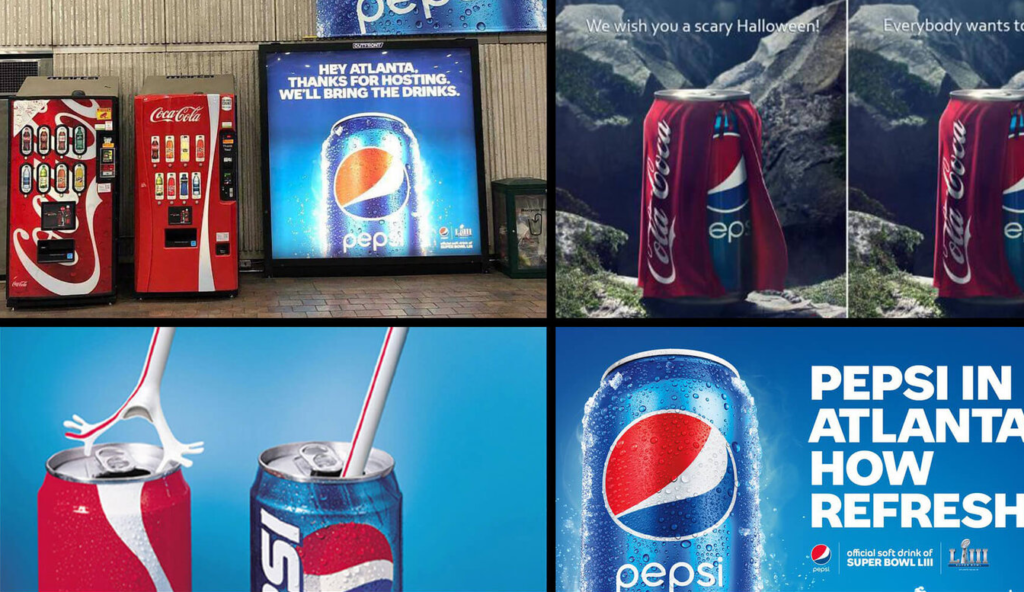
When it comes to its advertising strategy, Pepsi has always been way ahead. The brand was notably the first to invade the airwaves to broadcast an advertising message, as early as 1940. The brand also realized very quickly that to best reach a young audience, it had a keen interest in developing partnerships with celebrities in fashion. . Thus, in 1984 Pepsi signed its first partnership with Michael Jackson, who offered a cover of Billie Jean for the occasion.
More recently, in 2012, we saw Pepsi cans in the image of the King of Pop on our shelves to celebrate the 25th anniversary of his “Bad” album.
Another example of Pepsi’s advertising talent is the ambush marketing campaign organized during the 2006 FIFA World Cup in which the brand launched an “unofficial partner” campaign involving a dream ball team. round (Thierry Henry, David Beckham,…) against a Bavarian team.
Among the celebrities who have lent their image (and sometimes their voice) to the cola brand, we can mention Ray Charles, Britney Spears, the Spice Girls, and even Christina Aguilera. Pepsi has even made Hollywood movie-style commercials, like these two videos. The first, with the singers Pink, Beyoncé, and Britney Spears, recalls the film, Gladiator. As for the second, which reunites Beyoncé, Jennifer Lopez, and David Beckham, it is very reminiscent of Quentin Tarantino’s Kill Bill.
competition
For more than 100 years it has been a real war between the two cola giants: Coca-Cola and Pepsi. In France, the PepsiCo group, with its 6% market share, lags behind Coca-Cola, which holds 60% of sales in the soft drink market, but still remains ahead of Cadbury Schweppes and its shares. market share of 5%.
Hope! You find this study useful. Don’t forget to share it with your friends. Thank You.
Marketing strategy of other brands
McDonald’s marketing strategy: A benchmark in the fast food industry
Nike Marketing Strategy: The Case Study (Just Do It)
Puma Marketing Strategy Between Competition & Sponsorship
Electronics Giant Apple (Think different) Marketing Strategy
Red Bull Marketing Strategy: The Case Study
- Trackback: Adidas Marketing Strategy The Case Study (Impossible is Nothing) - Mix With Marketing
Leave a comment Cancel reply
Save my name, email, and website in this browser for the next time I comment.
You May Also Like

What is the Internet Of Things (IoT)? | Impact of IoT on today’s world

Newsletter with attachments
Instagram - Useful Tips For Successful Ad campaigns
Don't miss out on this amazing opportunity - subscribe now and start enjoying all the benefits!!!
No thanks, I’m not interested!
Newsletter Subscribe
Get the Latest Posts & Articles in Your Email
We Promise Not to Send Spam:)
MBA Knowledge Base
Business • Management • Technology
Home » Management Case Studies » Case Study: PepsiCo’s International Marketing Strategy
Case Study: PepsiCo’s International Marketing Strategy
Pepsi was created by chemist named Caleb Bradham . He was inspired to experiment with various products and ingredients to create a suitable summer drink that became highly sought after way back in the summer of 1898. It was this summer inspiration that later evolved into what we now know as Pepsi Cola. The company was launched officially in the year 1902. The beginning of Pepsi Cola was in the back room of his pharmacy, but recognizing its potential, Caleb soon started bottling the product so that people all over can enjoy it. As the years passed, Caleb started franchising the bottling of the drink to different people in different locations. Soon Pepsi Cola was being sold in 24 states across the United States. When World War I broke out, the company went bankrupt and Caleb had to sell the trademark to a stock broker from North Carolina. But he too could not revive the business. It was the candy manufacturer, Charles G. Guth , who bought it from the previous owner and revived it into the global brand it is today. Its marketing plan started even when the company was in the hands of Caleb and grew with the company. It was during World War II that the company adopted the red white and blue emblem to depict patriotic America. The color code still exists today though the emblem has evolved many times.

It was after 65 years after the sale of its first cola that PepsiCo started its diversification into other foods and beverages. Now the company not only sells Pepsi, its main brand, but also other items like Quaker Oats, Aquafina, Tropicana, Mountain Dew and Lays. It also had alliance with companies like Starbucks and Lipton to come out with special coffee and tea.
PepsiCo’s Marketing and Promotional Strategy
The current marketing strategy adopted by PepsiCo Inc. is definitely one that caters to its global standing. Since Pepsi came out at a time when Coke or Coca Cola already had a head start in the market, its market strategy and business plan began with differentiation – an attempt to establish its product as one that is unique in taste and quality. This approach was successful to a great extend and Pepsi was able to establish itself in the US markets. Later the plan shifted to comparative marketing and later to diversification.
Pepsi’s promotional campaigns had a lot to do with its success. Pepsi’s market environment always presented it with a challenge in the form of Coke which had already created a niche for itself.
In the 1940s to create a niche among the African American, Pepsi created a scholarship program that awarded 17 African American high school seniors full time scholarships. During the same time the ad campaigns of Pepsi featured top people from the African American community and they called it “Leader in their field” campaign. This campaign was quite a breakthrough and really made an impact. It opened up a whole new market segment for the company.
In the 1960s, Pepsi’s campaign was aimed at teenagers and young adults – beach bursting of youngsters having fun and drinking Pepsi was quite a common theme and popular too. It showed that Pepsi was the drink for partying and hanging out with friends, something the American youth could easily identify with. The “Pepsi Generation” theme became highly popular and the drink started creating a niche for itself among the young of the country. At first it was called “think young” campaign. This later evolved into “come alive” in the year 1965. This is when the term “Pepsi generation” was first introduced to the people.
In the 1970s Pepsi came out something called the “Pepsi Challenge”. This campaign was aimed at proving Pepsi as a better tasting drink than its rival Coke and involved blind tasting of the two products to choose the better one. Even though this helped improve the market share of PepsiCo, Coke still led the market.
Pop icons like Michael Jackson and Lionel Ritchie and youth sensation like Michael J Fox became part of the Pepsi campaigns in the 1980s where by Pepsi began to beat Coke and come out the winner. They had a huge fan following and when they were seen endorsing the brand, the impact was instantaneous. Pepsi also exploited famous movies of the time like Star Wars to improve their brand image and create interest among the people. However, Pepsi chose to replace the “Pepsi Generation” campaign with “Gotta Have It” in the beginning of the 1990s. This turned out to be an erroneous move and Coke again started to gain market share.
Pepsi and the Cola Wars
The cola wars began somewhere in the mid 1950s. The main players in the war were Pepsi and Coca Cola. The two companies had been in rivalry ever since Pepsi came out with its first cola. But the rivalry reached its zenith in the 1980s and 1990s. The main point was neither company had a cost advantage . Hence promotion was the main way of competing. In the 80s Pepsi started coming out with campaigns that undermined Coke. For example, a Pepsi ad came out which showed a group of retirement home people dancing to rock ‘n roll when they get the wrong delivery of a Pepsi crate instead of Coca Cola. It also used celebrity advertising vigorously. This gave Pepsi a lead in the market, though short lived. In the 1990s Coca Cola was beating Pepsi by huge margins again. The war was quite cut throat with Coca Cola doing everything possible to outrun Pepsi. This included stealing Pepsi’s bottlers, hoarding of Pepsi bottles and creating ads that hinted at ridiculing the Pepsi brand. In many countries Coca Cola were forcing retailers and bottlers to boycott the Pepsi brand. Upon learning about this Pepsi filed several anti-competitive cases out if which they won around 70. Yet, at one stage of the war Pepsi’s market value fell to less than half of Coca Cola’s market value. Coca Cola was and is still leading in when it comes to market share of its cola brand. The only way Pepsi could fight back was through diversification. It started spreading its wings to include sports beverages, varied versions of the Pepsi drink and non-carbonated beverages in its portfolio. It started considering itself as a “complete” beverage company. The diversification further happened to include snacks and food items like potato chips and oats. Diversification really helped Pepsi to improve its falling stand in the market not only in the local markets of America and Europe, but also in its international markets where Coke is leading the show.
Pepsi Goes International – Its Global Marketing Plans
In the 1940’s itself PepsiCo started branching out into the international arena. At first it was into Latin America, the Middle East and the Philippines. Here too Coke had the early bird advantage. Yet the product soon gained popularity. With the Arab countries boycotting Coke, Pepsi enjoyed a monopoly for many years in the Middle East. In the 1950’s Pepsi went to Europe and this included Russia, with whom there existed a Cold War by USA. Though there were initial difficulties, getting into Russia was a major breakthrough which the company exploited. The company posted pictures of the then leaders of the United States and Russia sipping the drink. Its arch rival, Coca Cola, was able to enter the Russian markets only after more than 25 years after Pepsi’s entry.
In many of the countries that Pepsi ventured into comparative advertising was prohibited and in many countries it was not an accepted concept. For example, Pepsi tried its “Pepsi challenge” promotional gimmick in Japan. However, the country and its people were not aware of comparative advertising and as such the campaign did more harm than good. Hence in Japan they had to break their tradition of running with the global campaign and come up with a campaign that the Japanese would identify with and was more Japanese. The “Pepsiman” was a superhero like figure that was devised by a Japanese person for the Japanese market. The commercial was an instant hit and helped improve Pepsi’s share in the Japanese market by as much as 14%. From Japan Pepsi learned a valuable lesson – the same ad will not have the same effect everywhere. When it comes to cross national advertising, there is always the inherent risk of alienating the people.
With the Indian markets, Pepsi had the first mover advantage over Coke. It had coined its own special slogan for the Indian market too that became quite popular with the crowd. Yet Coke re-entry into India was a great threat to the company. Coke signing on youth icon and Indian star Hrithik Roshan to do their campaign was an even bigger threat. However, Pepsi reverted to the old ploy of showing down the competition. They featured the king of Indian movies, Shah Rukh Khan and a Hrithik look alike. This comparative ad was effective and brought Pepsi back into the spot light.
In the USA and European markets Pepsi still uses promotional campaigns that aim to break the colour barriers with stars like Britney Spears, Beyonce and Haley Berry appearing in its ads. The brand and its products are highly popular in these areas. In the international arena, Pepsi has been able to create a niche through its vigorous advertisement and event sponsorship. In fact more than 45% of the total revenue of the company comes from its market outside the USA. However the company has experience many setbacks due to its many blunders have cost it valuable market share.
Marketing Blunders
One of the major blunders that Pepsi did in its marketing runs is the literal translations of some of its slogans into other languages. For example PepsiCo’s slogan “Come Alive with the Pepsi Generation” when translated into Taiwanese meant “Pepsi will bring your ancestors back from the dead” and caused great damage for its image. It was the perfect example of the wrong market message. Similarly, the goodwill of the company suffered a heavy blow when its bottle cap campaign (number inside the cap and a few winning numbers win fabulous prizes) in Chile ended in wreckage of the company. This was caused by a wrong fax being sent and the wrong number being announced on TV. Almost a similar incident repeated in the Philippines as well a few months later when, due to a computer glitch, instead of one winner several winners were announced for the bottle cap sweepstakes. Instead of learning from a blunder in one country, it was repeated in another, causing further harm to its brand image.
A more recent marketing blunder happened in the United States of America itself. In 2010, Pepsi decided not to spend big bucks for sponsoring the Super Bowl . The Super Bowl is a sporting event in the States that is watched by almost all Americans and hence its wide reach is indisputable. Instead, it decided to do social marketing through its internet based “Refresh” campaign. Though the effort was commendable it was a major blunder. Instead of using the Super Bowl to further give lime light to the Refresh campaign, it completely missed the opportunity paving way for others to make use of the spot.
Related posts:
- Case Study: L’Oreal International Marketing Strategy
- Case Study of Kellog’s: Marketing Strategy for Latin America
- Case Study: Starbucks Social Media Marketing Strategy
- Case Study on Marketing Strategy: Starbucks Entry to China
- Case Study: Marketing Strategy Analysis of Apple iPad
- Case Study: Airbnb’s Growth Strategy Using Digital Marketing
- Case Study: Marketing Strategy of Walt Disney Company
- Case Study of Dell: Simple but Effective Marketing Strategy
- Case Study: L’Oreal Global Branding Strategy
- Case Study: Marketing Strategies of IBM
Leave a Reply Cancel reply
Your email address will not be published. Required fields are marked *
